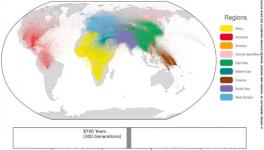Precise Editing of DNA Gives New Hope For Treating Genetic Diseases

Credits: ExtremeTech
After the revolutionary gene editing technique CRISPR was discovered five years ago, a new breakthrough has been made in the field of gene therapy — base editing. Two studies published in Science and Nature this week advance CRISPR tools further by “base editing”. One study extends a strategy for base editing DNA, whereas the other breaks new ground by base editing its molecular cousin, RNA.
CRISPR allows scientists to make changes in the DNA of humans, as well as plants and other animals. DNA is a molecule which carries instructions for the body to grow, develop, reproduce, and function. Sometimes, there can be errors in the DNA sequence, called mutations. These errors can result in genetic disorders, such as blindness, heart problems, mental illness, etc. Some of these disorders are caused by a type of mutation known as a point mutation.
Editing DNA can possibly cure these genetic disorders. CRISPR proposes to fix mutations by removing the faulty DNA sequence in the genome, and replacing it with a healthy one.
CRISPR created a lot of excitement in scientific communities as it is more accurate, faster, and cheaper than any other genome editing methods. While it holds a lot of promise, it has been noted that it is not as efficient at making precise changes as the new base editing technique.
Base editing does something more specific. DNA is made of four bases — A, G, C, and T. These bases exist in the DNA in pairs, called base-pairs (A-T and G-C).

A lot of mutations occur in the form of point-mutations, which are caused due to base-pairs being at incorrect locations in the DNA sequence. They are responsible for 32,000 out of 50,000 genetic disorders. Instead of deleting and inserting an entire DNA sequence, base editing allows us to change an incorrect base-pair into a correct one, without affecting the overall DNA structure. Research teams in China are already using base editing to fix a mutation in a human embryo cloned from a patient suffering from a genetic blood disorder.
Two research teams, one at Harvard and the other at MIT, carried out base editing research which was published this week. The team at Harvard, led by David Liu, was able to perform a base-pair edit in DNA which can address about half of the 32,000 disease-causing point mutations.
The team at MIT, led by Feng Zhang, were able to successfully carry out similar base edits in RNA, the chemical cousin of DNA. RNA has a much shorter life span in the cell compared to DNA, which makes its editing less effective in many gene therapies. However, editing the bases of RNA is considered safer as RNA naturally degrades in the body. So the changes caused by RNA base editing will not result in a permanent change in a person’s genome, and will also not be passed on to the next generation.
While this is an exciting development, both Zhang and Liu say that it could take several years before base editing can be used in clinical trials. It also remains to be established if base editing can offer significant advantages over exiting gene therapy techniques. But it is a significant development of CRISPR.
Disclaimer: The views expressed here are the author's personal views, and do not necessarily represent the views of Newsclick.
Get the latest reports & analysis with people's perspective on Protests, movements & deep analytical videos, discussions of the current affairs in your Telegram app. Subscribe to NewsClick's Telegram channel & get Real-Time updates on stories, as they get published on our website.
























